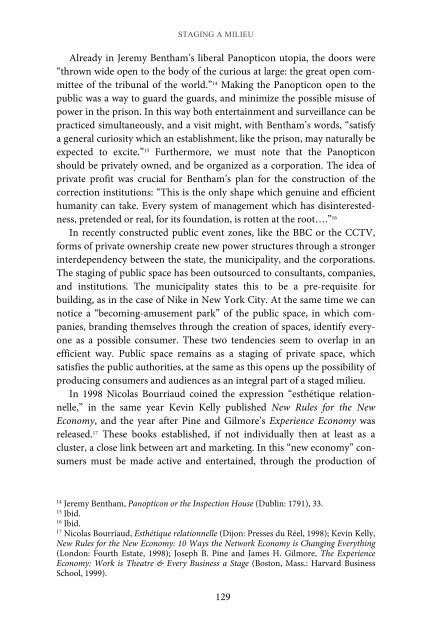Foucault, Biopolitics, and Governmentality
Foucault, Biopolitics, and Governmentality
Foucault, Biopolitics, and Governmentality
Create successful ePaper yourself
Turn your PDF publications into a flip-book with our unique Google optimized e-Paper software.
STAGING A MILIEU<br />
Already in Jeremy Bentham’s liberal Panopticon utopia, the doors were<br />
“thrown wide open to the body of the curious at large: the great open committee<br />
of the tribunal of the world.” 14 Making the Panopticon open to the<br />
public was a way to guard the guards, <strong>and</strong> minimize the possible misuse of<br />
power in the prison. In this way both entertainment <strong>and</strong> surveillance can be<br />
practiced simultaneously, <strong>and</strong> a visit might, with Bentham’s words, “satisfy<br />
a general curiosity which an establishment, like the prison, may naturally be<br />
expected to excite.” 15 Furthermore, we must note that the Panopticon<br />
should be privately owned, <strong>and</strong> be organized as a corporation. The idea of<br />
private profit was crucial for Bentham’s plan for the construction of the<br />
correction institutions: “This is the only shape which genuine <strong>and</strong> efficient<br />
humanity can take. Every system of management which has disinterestedness,<br />
pretended or real, for its foundation, is rotten at the root….” 16<br />
In recently constructed public event zones, like the BBC or the CCTV,<br />
forms of private ownership create new power structures through a stronger<br />
interdependency between the state, the municipality, <strong>and</strong> the corporations.<br />
The staging of public space has been outsourced to consultants, companies,<br />
<strong>and</strong> institutions. The municipality states this to be a pre-requisite for<br />
building, as in the case of Nike in New York City. At the same time we can<br />
notice a “becoming-amusement park” of the public space, in which companies,<br />
br<strong>and</strong>ing themselves through the creation of spaces, identify everyone<br />
as a possible consumer. These two tendencies seem to overlap in an<br />
efficient way. Public space remains as a staging of private space, which<br />
satisfies the public authorities, at the same as this opens up the possibility of<br />
producing consumers <strong>and</strong> audiences as an integral part of a staged milieu.<br />
In 1998 Nicolas Bourriaud coined the expression “esthétique relationnelle,”<br />
in the same year Kevin Kelly published New Rules for the New<br />
Economy, <strong>and</strong> the year after Pine <strong>and</strong> Gilmore’s Experience Economy was<br />
released. 17 These books established, if not individually then at least as a<br />
cluster, a close link between art <strong>and</strong> marketing. In this “new economy” consumers<br />
must be made active <strong>and</strong> entertained, through the production of<br />
14 Jeremy Bentham, Panopticon or the Inspection House (Dublin: 1791), 33.<br />
15 Ibid.<br />
16 Ibid.<br />
17 Nicolas Bourriaud, Esthétique relationnelle (Dijon: Presses du Réel, 1998); Kevin Kelly,<br />
New Rules for the New Economy: 10 Ways the Network Economy is Changing Everything<br />
(London: Fourth Estate, 1998); Joseph B. Pine <strong>and</strong> James H. Gilmore, The Experience<br />
Economy: Work is Theatre & Every Business a Stage (Boston, Mass.: Harvard Business<br />
School, 1999).<br />
129


